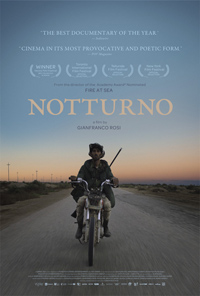Darkest Nocturne Before the Dawn: Rosi’s Vision of War-Torn Lives
 Filmed on the borders of Iraq, Lebanon, Syria and Kurdistan over the past three years, Notturno offers breathtaking tableaux of the war-torn Middle East. Like Gianfranco Rosi’s previous award-winning docs, Sacro GRA and Fire at Sea, Notturno opts for art-as-journalism, sharing narrative glimpses through painterly frames as opposed to interviews or narration. Rosi’s visuals are indeed gorgeous—with cleverly manipulated audio for added flavor—but his message is more opaque than in previous films. Here, his hyper-aesthetic restraint delivers powerful moments that feel both fragmented and confounding.
Filmed on the borders of Iraq, Lebanon, Syria and Kurdistan over the past three years, Notturno offers breathtaking tableaux of the war-torn Middle East. Like Gianfranco Rosi’s previous award-winning docs, Sacro GRA and Fire at Sea, Notturno opts for art-as-journalism, sharing narrative glimpses through painterly frames as opposed to interviews or narration. Rosi’s visuals are indeed gorgeous—with cleverly manipulated audio for added flavor—but his message is more opaque than in previous films. Here, his hyper-aesthetic restraint delivers powerful moments that feel both fragmented and confounding.
As viewers, we feel like voyeurs—but Notturno doesn’t feel like a documentary. Rosi’s masterful use of camera and sound achieves the staged precision of a feature film while preserving the authenticity of unrehearsed tragedy. Treading the fringes of war, he shines his light on needless suffering and moments of hard-found normalcy. Hauntingly beautiful bombed-out cities, mud-caked streets, wind-challenged tents and a nighttime canoe ride lit by a distant inferno evoke life in purgatory: with a palette of earth tones and moody blues, these are museum-worthy screengrabs, a mix of literal and metaphorical, ranging from austere Courbet to emotive Caravaggio. Particularly effective are juxtaposed scenes of bird-hunting riflemen and soldiers, both lying in wait for prey: the telling contrast of purposeful vs. pointless killing—where only the birdhunt concludes. The soldiers are trapped in a never-ending nightmare.
Amidst Notturno’s abstractions are bursts of heart-shattering realism: a mother listening to increasingly frantic voicemails from her kidnapped daughter; a traumatized boy illustrating the massacre of his village with spurts of red crayon. These scenes are beyond painful, but lack context. As standalone character moments in a sea of visual poetry, they feel tonally dissonant, even borderline salacious—and instead of adding richer subtext, they distract. When a psych-ward’s theater company provides fragments of cultural backstory during rehearsals, they give us hints without substance: as if Rosi were constricted by his own style, caught in an artistic purgatory of his own making.
Notturno’s images speak volumes, but the sum of its parts is no more coherent than war-torn life itself: a sad truth on both counts—especially for those who prefer a more linear narrative. Rosi’s latest opus invites comparison to Feras Fayyad’s excellent The Last Men in Aleppo (2017) and The Cave (2019). All three films explore war in the Middle East, all three invite audiences to tackle difficult questions—but Fayyad chooses to humanize tragedy through powerful narratives with an undercurrent of hope, while Rosi relies on visual metaphor, refusing to hold the viewer’s hand while arousing awareness. Both filmmakers have worthy intentions—but Fayyad’s characters follow an emotional arc, while Rosi’s are glimpsed through brief anecdotes and facial expressions. Because of this, Notturno may work best for some as a companion piece to other Middle East films: a mood-driven poem underscoring both the horrors of war and the personal battles that, much like Rosi’s eloquent images, take place on the fringes of our awareness.
★★★/☆☆☆☆☆


